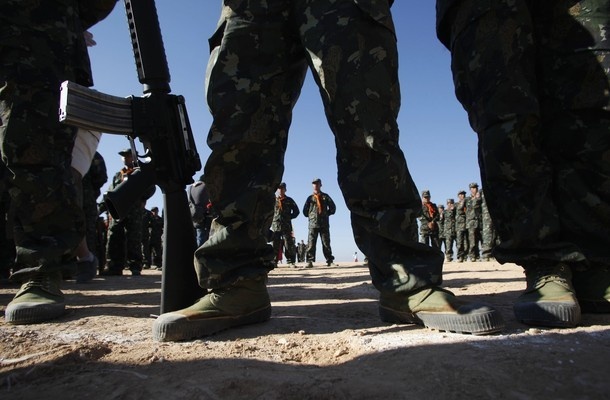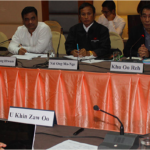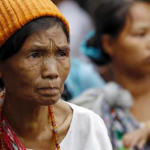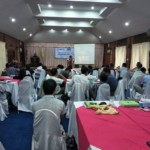Moe Gyo, DVB | September 2, 2015
According to accepted negotiating practice, no agreement is better than a bad agreement. Nonetheless, many ethnic armed organisations (EAOs) are now agreeing to sign the current Nationwide Ceasefire Agreement (NCA).
It is as if – just like Alice in Lewis Carroll’s Alice’s Adventures in Wonderland – these EAOs have gone down a rabbit hole into a Ceasefire Wonderland created by the Tatmadaw
The ethnic delegation even reformed its negotiating team with more senior and seemly more pragmatic leaders. Yet despite more senior leadership, the NCA at hand does not explicitly address the key issues of federalism; inclusiveness of all EAOs; effective ceasefire monitoring; and the resulting consequences should the political dialogue not commence (or if commenced, not be concluded).
These issues are not new: many hark back to the Panglong Conference (1947); Shan Federal Proposal (1961); defunct Federal Conference (1962); and the multitude of ceasefire agreement of the 199os.
Over this ensuing period, the lives of the ethnic people have not been normal as they endured war in
their lands and were subject to all manners of human rights violations – killings, landmine deaths/injuries, rape, burning of villages and places of worship, forced labor, confiscations of land and possessions, and others, some of which could be construed as war crimes under international law.
Many ethnic people have spent years in refugee camps, been resettled in other countries, have hidden and sheltered in the jungle as internally displaced persons, or emigrated to work in neighbouring countries in often dirty, dangerous, and degrading conditions. They have been kept by the successive Burman military governments at the bottom of Maslow’s Need Hierarchy in poor health, given little education, and have poor livelihood opportunities. The EAO soldiers have died or been permanently maimed from over 65 years of warfare.
Despite all of this suffering, the EAO leaders are acceding to the Tatmadaw by agreeing to this bad ceasefire agreement. And the ethnic media attributes this situation to the “divide and rule” strategy of the government. The EAO leaders have made the decision themselves to accept this agreement, so they are personally to blame.
Yet the ethnic people also share the blame for allowing their leaders to represent their political aspirations. Have they not suffered enough to be driven towards replacing these bad leaders? Perhaps with more suffering, they will rid themselves of their history of poor leadership. To be sure, the Tatmadaw will help them with more suffering as they break the NCA without serious consequences.
So why is this ceasefire agreement so bad?
One not need to look too far into the NCA to find faults. Take the very first chapter – Basic Principles. The EAOs agreed to the Three Causes, but a federal Union of Myanmar would only be “in accordance with the outcomes of a future political dialogue”. So the EAOs agree not to secede from the Union and only get the government to agree to talk about the principles of federalism in a future political dialogue.
For over 60 years, it has been about the self-determination rights/self-autonomy of the ethnic people, yet the EAOs agree to a ceasefire, but do not get the government to explicitly agree to the equitable power and resource-sharing as promised in the Panglong Agreement. This a betrayal by the EAO leadership to the longstanding political, social, and economic aspirations of the ethnic people as embodied in ‘federalism’ with its shared equitable Union-State sovereignty, so that the ethnic people can protect and promote their legitimate interests and enjoy the benefits of their lands and culture.
Burma’s military does not want genuine federalism since it would result in a significant weakening of their control at the sub-Union levels.
In respect to Ceasefire Related Matters and Maintaining and Strengthening Ceasefire Agreements, there is still no formal Military Code of Conduct. It has been three years now since the temporary ceasefire agreements with talk about concluding Military Codes of Conduct. The Tatmadaw has done everything it could to delay any meaningful dialogue about this important issue. A Military Code of Conduct should have been a part of this NCA as with the many ceasefire agreements concluded elsewhere in the world.
The NCA speaks of the monitoring of the agreement through a Joint Monitoring Committee of the Tatmadaw and the EAOs. We have seen in both Shan and Kachin states that such joint monitoring schemes do not work. For ceasefire agreements to be effectively monitored, international ceasefire monitors should be employed such as the Organisation for Security and Cooperation in Europe (OSCE) or the European Community, both of whom are considered impartial and have decades of experience in this field.
If on the other hand, ceasefire monitors must come from ASEAN, then the Philippines is the only ASEAN member country that does not have tangible economic interests or relationships with Burma, and has the capacity to mount such ceasefire monitoring operations. So why did the EAOs not consider deployable international ceasefire monitors as a “core issue” for inclusion in the NCA? Everyone knows the Burmese military treats ceasefire agreements lightly and will break them when political means are unable to accomplish their tactical or strategic objectives. But then again, the EAOs are wallowing in a Ceasefire Wonderland where illogic is logical.
Then there are the Guarantees for Political Dialogue. And what transpires should there be no political dialogue? Or even if there is, but no conclusion? Does the NCA become null and void after a specific period of time or is it subject to renegotiation? And with the inclusion of the democratic and ethnic political parties, parliament, military, executive branch, civil society organisations, EAOs, and who knows what others, the Tatmadaw can count on never-ending political negotiations. The elections will also delay a political dialogue until a new government is installed in March 2016. These concerns are not addressed in the NCA, and are certainly a benefit to the military.
Both Naypyidaw and the senior ethnic delegates are employing dubious mathematics in deciding how many EAOs are necessary to sign the NCA to make it a truly ‘nationwide’ ceasefire agreement. Notably left out are the Myanmar Nationalities Democratic Alliance Army (MNDAA), Ta-ang National Liberation Army (TNLA), and the Arakan Army (AA). As for the United Wa State Army, it will most likely decline to sign the NCA unless it gets some assurances about a discussion of its own Wa State.
So in this Ceasefire Wonderland, ‘nationwide’ does not mean ‘nationwide’. Therefore the Tatmadaw will be free to pursue offensive operations against the MNDAA, TNLA, and AA without breaking the NCA … so much for the much-touted ethnic unity. Again, it is the EAOs who have divided themselves, not the military.
We saw the so-called “core issue” of Witnesses and Observers to the NCA Signing brought up. This is just a red herring that the EAOs have bought from the UPWC. What is so “core” about this issue of who should be there to watch people from the government and the EAOs sign the NCA? Will it stop any subsequent ceasefire violations by the Tatmadaw or force Naypyidaw into genuine political negotiations about federalism? I think not. This is just a bone that the government kept in its pocket to throw at the right time to the EAOs when they needed some compromises – just one of several strategic bones thrown in the direction of the EAOs.
Who should be the Signatories from the Government and the EAOs to Sign the NCA? The answer here should be very obvious and not subject to long discussions: the president; parliamentary speaker; commander-in-chief; attorney-general; and EAO leaders. The NCA should become law through a special session of the Union Parliament with no changes and within 30 days of its signing.
It should be noted that this approval by the Union Parliament does not constitute recognition by the EAOs of the 2008 Constitution, but merely codifies the government’s legal commitment to the NCA. But this phraseology is noticeably absent from the NCA.
Though not in the NCA, Security Sector Reform should place the Union army directly under an elected Union president; reduce its size, budget, armaments, and also the distribution of its units in the ethnic states to a size of a country at peace; separate the police force from the Tatmadaw; and integrate EAO forces into state militias under the peacetime control of elected state chief ministers, but under the Tatmadaw only in times of external threats.
So assuming the EAOs will sign this bad NCA, where do we go from there? Based upon past history, Burmese government forces can be expected to violate the NCA, delay the conclusion of a meaningful Military Code of Conduct, delay or otherwise obstruct any political dialogue, and definitely not agree to genuine federalism.
The first step by the ethnic people then is to replace those EAO leaders who signed the NCA with leaders who truly embrace and will strive earnestly to achieve the social, economic, and political aspirations as embodied in genuine federalism. Without this step, no progress can be made toward these aspirations.
Once this is accomplished, the EAOs should:
• Establish an Ethnic Federal Army (EFA) with Western (ALP, AA, & CHF), Northern (KIA, TNLA, ABSDF, SSA-N, PNLO, & SSA-S), and Eastern Commands (KNPP, KNLA, DKBA, KPC, & NMSA) that are able to effectively mount and coordinate military operations nationwide, when needed. The UWSA and the NDAA have their own political and economic agendas are thus not amenable to combined commands.
• Recruit and train new EFA soldiers, and enhance armaments.
• Organise an EFA electronic army from among the ethnic diaspora to support EFA military operations.
• Identify high-value Tatmadaw formations and assets, especially in the non-ethnic areas, and formulate the plans/means to degrade them if it becomes necessary.
• Form effective international advocacy organisations, separate from those of the NLD and Burmans, to promote ethnic voices and aspirations.
Upon any tangible ceasefire violations or intentional delays in/obstruction of political dialogue by the Tatmadaw:
- Halt all investment and development in EAO-administered areas;
- Deny entry of UN agencies or INGOs, who have government MOUs, into EAO-administered areas;
- Expel all government workers from EAO-administered areas.
- Upon massive ceasefire violations by the Tatmadaw, withdraw from the NCA and mount coordinated offensive military operations throughout Burma with the objective of attaining an overwhelming EAO bargaining position or changing the government.
History shows that the ethnic people cannot trust the Tatmadaw. Thus during any post-NCA signing period, the EAOs must prepare, once and for all, to engage in a final armed struggle to obtain an overwhelming bargaining position or change the government for the realisation of true federalism; or secede from the Union. Yes, as in the “Panglong Spirit” so often touted, the EAOs must seriously consider secession from the Union as proposed by Gen. Aung San should the ethnic people not realise the benefits of a common union with the Burmans.
To this last respect, Burma could be viewed as a ‘manufactured country’ similar to the former Yugoslavia. The Burmans and the ethnic people were manufactured into a Union of Burma by the British and Burmans through the Panglong Agreement. It has been a ‘marriage’ with verbal and physical abuse by the Tatmadaw upon the ethnic peoples. As with a marriage between a man and a woman with ongoing verbal and physical abuse, maybe this is the time for a divorce, i.e., secession, once and for all. ‘Counseling’ has not worked over the past 65 years.
The Burmans have not shown the benefits of a common union to the ethnic people: their Tatmadaw only issues threats followed by physical force to compel the ethnic people to remain in the Union. Aung San foresaw this situation and gave the ethnic people the right to secede from the Union after ten years if they did not see the benefits. This is the time to reconsider this option, especially for the ethnic people along the Thai border who may be able to negotiate with Thailand for a special autonomous commonwealth state under the Thai kingdom, but not be a part of Thailand proper. This would be in return for economic concessions and a geographic buffer with Burma. There are shared kinships with ethnic people inside Thailand which are not similarly shared with the Burmans and also there is a shared history of Burman aggression against both the ethnic and Thai people.
It is time for the EAOs to climb out of this Tatmadaw-fabricated Ceasefire Wonderland with new 21st -century leaders who can convert the aspirations of the ethnic people into reality. Past generations of ethnic leaders have failed to do. If they can indeed achieve these ethnic aspirations, then they will be in the history books for future generations to truly honor as liberators, not martyrs.
Moe Gyo is a political consultant and strategist working for Strategic Border Consulting in Mae Sot, Thailand.
The views and opinions expressed in this article are the author’s and do not reflect DVB editorial policy.
This analysis originally appeared on the Democratic Voice of Burma (DVB) on September 2, 2015.







